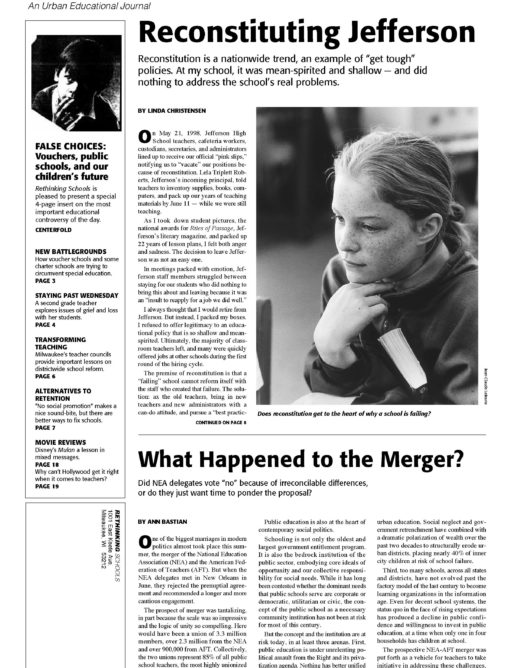Preview of Article:
What Happened to the Merger?
Did NEA delegates vote "no" because of irreconcilable differences, or do they just want time to ponder the proposal?
For all of its promise, the merger failed overwhelmingly in the hands of NEA delegates. Only 42% supported the proposal, far short of the 67% required for ratification. Did the partners suffer irreconcilable differences? Or did they just need more time?
Reports on the vote focused on what delegates perceived as critical differences between the two unions. Some felt the merger threatened NEA’s democratic representative assembly process; some were threatened by AFT’s history of militant strikes, and others by the fear that AFL-CIO affiliation would degrade their professionalism.
What is striking is not just that opposition spanned a wide spectrum of political consciousness, from concerns about union democracy to class snobbery. It is also striking that so many of the reasons cited were superficial and misperceived. The reality is that the two teacher unions are not profoundly different.
To be sure, the NEA and AFT have traveled different paths. The NEA is a century old and most of that time has been spent as a professional association and advocacy organization. The AFT was forged as a union in the public employee recognition struggles of the 1960s.
NEA is a sprawling network of powerful and autonomous state associations, run by a permanent cadre of staff (sometimes labeled bureaucratic), with its largest base in suburban districts. The AFT has had, until recently, one leader (sometimes labeled autocratic) presiding over a chain of centralized locals in the big industrial cities. The NEA has stood outside the rest of the labor movement and has, by and large, espoused the most consistently progressive social platform of any union. The AFT has been in the thick of AFL-CIO politics, on the side of Cold Warriors as well as social liberals. The two unions also have different organizational cultures. Stylistically, the AFT is from Mars, the NEA is from Venus.</p

